Degradation of Kinematic PPP of GNSS Stations in Central Europe Caused by Medium-Scale Traveling Ionospheric Disturbances During the St. Patrick’s Day 2015 Geomagnetic Storm
Abstract
:1. Introduction
2. The St. Patrick’s Day 2015 Geomagnetic Storm
3. Methodology and Data
4. Results
5. Discussion
6. Conclusions
Author Contributions
Funding
Acknowledgments
Conflicts of Interest
Appendix A
| Station Name | Latitude | Longitude | Altitude (m) |
|---|---|---|---|
| BART | 54°15″02.52′ | 20°48″55.57′ | 93.2 |
| CCHN | 52°52″58.03′ | 20°35″52.18′ | 167.7 |
| CHNO | 53°09″50.58′ | 15°24″50.54′ | 105.4 |
| CHOJ | 53°41″42.65′ | 17°33″08.47′ | 204.1 |
| GIZY | 54°02″08.81′ | 20°10″02.53′ | 166.8 |
| GOLE | 53°33″31.36′ | 14°50″16.81′ | 68.8 |
| ILAW | 53°35″13.64′ | 19°34″04.66′ | 162.8 |
| KAM1 | 53°57″47.01′ | 14°46″38.61′ | 57.8 |
| KOSZ | 54°12″12.19′ | 16°11″51.79′ | 123.2 |
| LAMA | 53°53″32.63′ | 20°40″11.77′ | 187.0 |
| PPIL | 53°09″25.11′ | 16°44″17.73′ | 121.7 |
| SOKL | 53°24″30.75′ | 23°29″44.66′ | 222.2 |
| STRG | 53°57″58.70′ | 18°31″47.96′ | 136.3 |
| WLAD | 54°47″48.32′ | 18°25″07.49′ | 34.7 |
| WRKI | 52°42″19.98′ | 16°22″15.87′ | 95.3 |
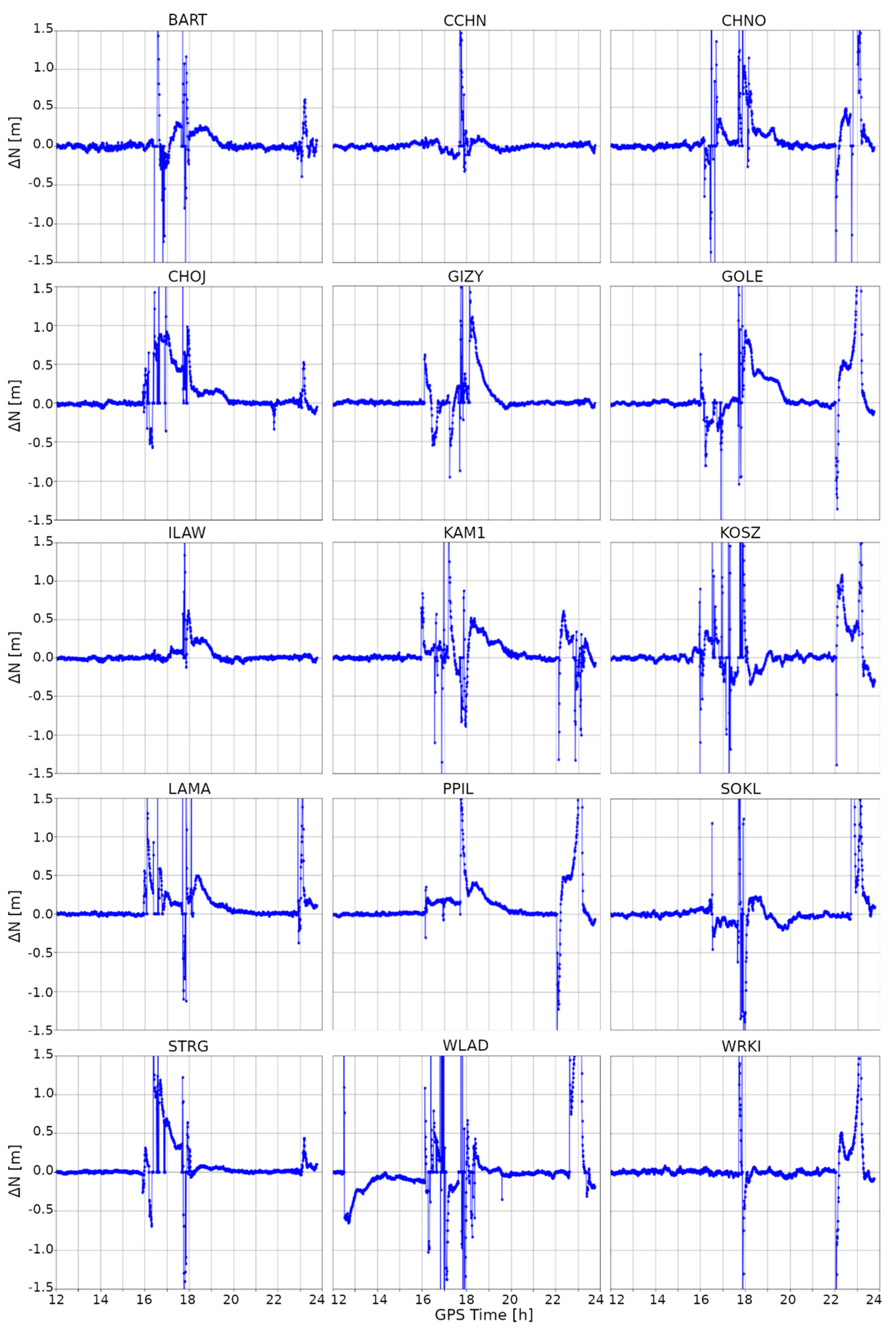
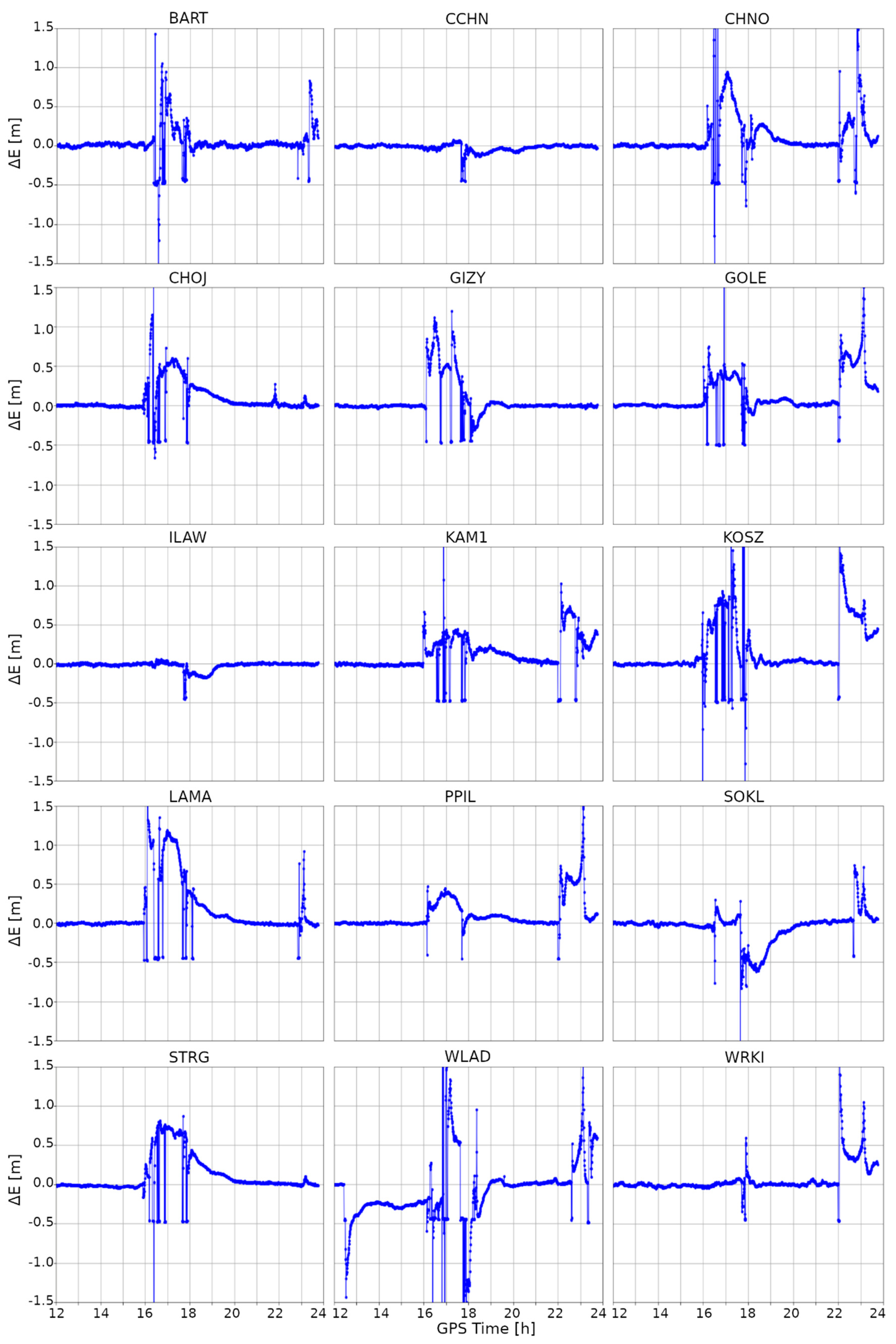
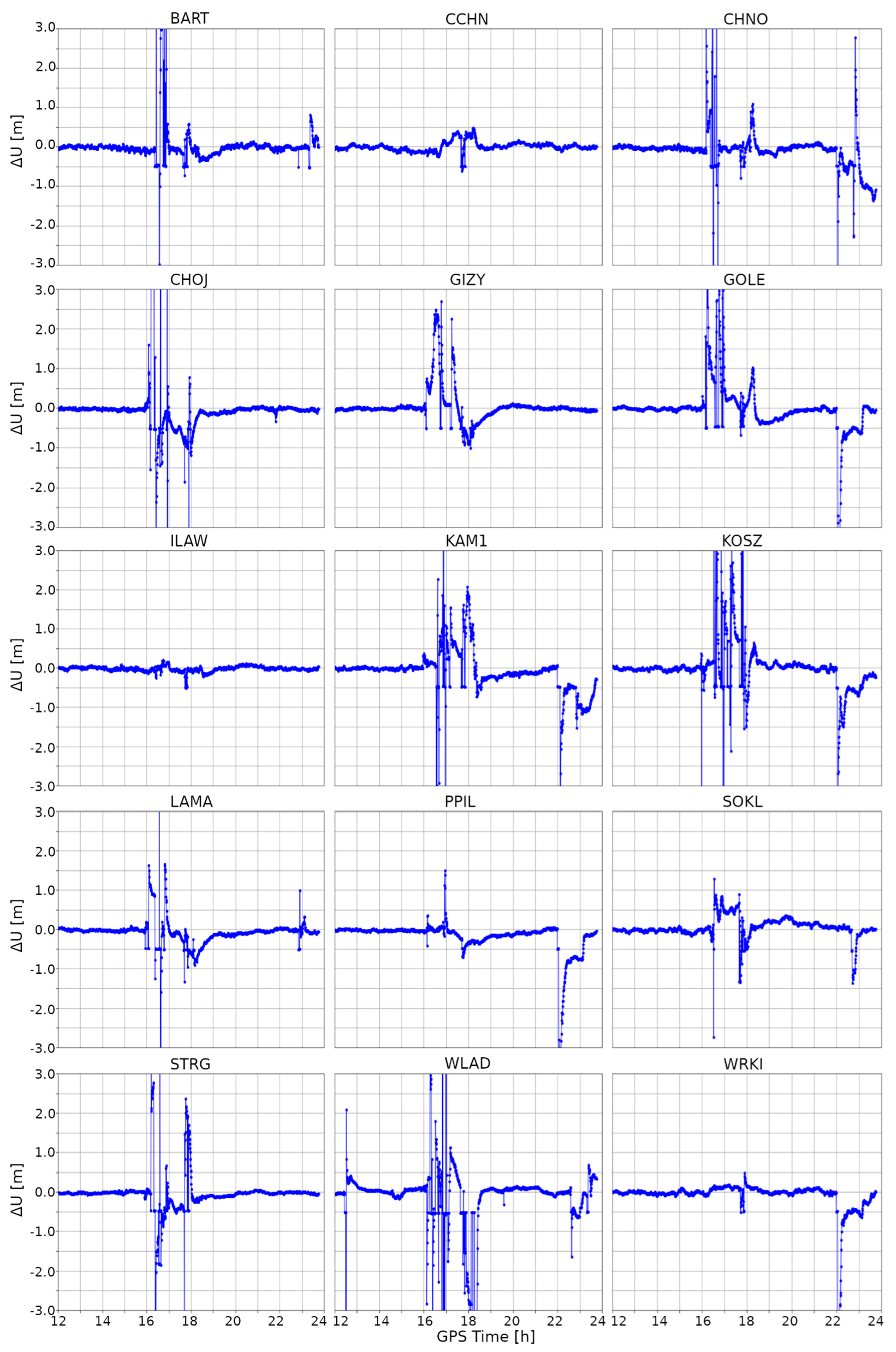
References
- Klobuchar, J.A. Ionospheric Time-Delay Algorithm for Single-Frequency GPS Users. IEEE Trans. Aerosp. Electron. Syst. 1987, 3, 325–331. [Google Scholar] [CrossRef]
- European Commission. European GNSS (Galileo) Open Service—Ionospheric Correction Algorithm for Galileo Single Frequency Users; European Commission: Brussels, Belgium, 2016; Issue 1.2. [Google Scholar]
- Wang, N.; Zishen, L.; Li, M.; Yuan, Y.; Huo, X. GPS, BDS and Galileo ionospheric correction models: An evaluation in range delay and position domain. J. Atmospheric Solar-Terrestrial Phys. 2018, 170, 83–91. [Google Scholar] [CrossRef]
- Kaplan, E.D.; Hegarty, C.J. Characterisation of GNSS Space Service Volume. In Understanding GPS: Principles and Applications, 2nd ed.; Artech House Inc.: London, UK, 2006. [Google Scholar]
- Wielgosz, P.; Kashani, I.; Grejner-Brzezinska, D. Analysis of long-range network RTK during a severe ionospheric storm. J. Geod. 2005, 79, 524–531. [Google Scholar] [CrossRef]
- Hernández-Pajares, M.; Juan, J.M.; Sanz, J.; Orús, R. Second-order ionospheric term in GPS: Implementation and impact on geodetic estimates. J. Geophys. Res. 2007, 112, B08417. [Google Scholar] [CrossRef]
- Kouba, J.; Héroux, P. Precise point positioning using IGS orbit and clock products. GPS Solutions 2001, 5, 12–28. [Google Scholar] [CrossRef]
- Ge, M.; Gendt, G.; Rothacher, M.; Shi, C.; Liu, J. Resolution of GPS carrier-phase ambiguities in Precise Point Positioning (PPP) with daily observations. J. Geod. 2008. [Google Scholar] [CrossRef]
- Veettil, S.V.; Aquino, M.; Marques, H.A.; Moraes, A. Mitigation of ionospheric scintillation effects on GNSS precise point positioning (PPP) at low latitudes. J. Geod. 2020, 94, 15. [Google Scholar] [CrossRef] [Green Version]
- Marques, H.A.; Marques, H.A.S.; Aquino, M.; Veettil, S.V.; Monico, J.F.G. Accuracy assessment of Precise Point Positioning with multi-constellation GNSS data under ionospheric scintillation effects. J. Space Weather. Space Clim. 2018, 8, A15. [Google Scholar] [CrossRef]
- Crowley, G.; Azeem, I. Extreme Ionospheric Storms and Their Effects on GPS Systems. Extreme Events Geospace 2018, 555–586. [Google Scholar] [CrossRef]
- Weng, D.; Shengyue, J.; Wu, C.; Zhizhao, L. Assessment and Mitigation of Ionospheric Disturbance Effects on GPS Accuracy and Integrity. J. Navig. 2014, 67, 371–384. [Google Scholar] [CrossRef] [Green Version]
- Crowley, G.; Azeem, I.; Reynolds, A.; Duly, T.M.; McBride, P.; Winkler, C.; Hunton, D. Analysis of traveling ionospheric disturbances (TIDs) in GPS TEC launched by the 2011 Tohoku earthquake. Radio Sci. 2016, 51, 507–514. [Google Scholar] [CrossRef]
- Kong, J.; Yao, Y.; Xu, Y.; Kuo, C.; Zhang, L.; Liu, L.; Zhai, C. A clear link connecting the troposphere and ionosphere: Ionospheric reponses to the 2015 Typhoon Dujuan. J. Geod. 2017, 91, 1087–1097. [Google Scholar] [CrossRef]
- Luo, X.; Gu, S.; Lou, Y.; Xiong, C.; Chen, B.; Jin, X. Assessing the Performance of GPS Precise Point Positioning Under Different Geomagnetic Storm Conditions during Solar Cycle 24. Sensors 2018, 18, 1784. [Google Scholar] [CrossRef] [PubMed] [Green Version]
- Rao, P.V.S.R.; Krishna, S.G.; Prasad, J.V.; Prasad, S.N.V.S.; Prasad, D.S.V.V.D.; Niranjan, K. Geomagnetic storm effects on GPS based navigation. Ann. Geophys. 2009, 27, 2101–2110. [Google Scholar] [CrossRef] [Green Version]
- Moreno, B.; Radicella, S.; de Lacy, M.C.; Herraiz, M.; Rodriguez-Caderot, G. On the effects of the ionospheric disturbances on precise point positioning at equatorial latitudes. GPS Solutions 2011, 15, 381–390. [Google Scholar] [CrossRef]
- Jacobsen, K.S.; Andalsvik, Y.L. Overview of the 2015 St. Patrick’s day storm and its consequences for RTK and PPP positioning in Norway. J. Space Weather. Space Clim. 2016, 6, A9. [Google Scholar] [CrossRef]
- Lu, Y.; Wang, Z.; Ji, S.; Chen, W. Assessing the positioning performance under the effects of strong ionospheric anomalies with multi-GNSS in Hong Kong. Radio Sci. 2020, 55, e2019RS007004. [Google Scholar] [CrossRef]
- Yasyukevich, Y.; Vasilyev, R.; Ratovsky, K.; Setov, A.; Globa, M.; Syrovatskii, S.; Yasyukevich, A.; Kiselev, A.; Vesnin, A. Small-Scale Ionospheric Irregularities of Auroral Origin at Mid-latitudes during the 22 June 2015 Magnetic Storm and Their Effect on GPS Positioning. Remote Sens. 2020, 12, 1579. [Google Scholar] [CrossRef]
- Hernandez-Pajares, M.; Juan, J.; Sanz, J.; Orus, R.; Garcia-Rigo, A.; Feltens, J.; Komjathy, A.; Schaer, S.; Krankowski, A. The IGS VTEC maps: A reliable source of ionospheric information since 1998. J. Geodesy 2009, 83, 263–275. [Google Scholar] [CrossRef]
- Krypiak-Gregorczyk, A.; Wielgosz, P.; Gosciewski, D.; Paziewski, J. Validation of approximation techniques for local total electron content mapping. Acta Geodyn. Geomater. 2013, 10, 275–283. [Google Scholar] [CrossRef] [Green Version]
- Figueiredo, C.; Wrasse, C.; Takahashi, H.; Otsuka, Y.; Shiokawa, K.; Barros, D. Large-scale traveling ionospheric disturbances observed by GPS dTEC maps over North and South America on Saint Patrick’s day storm in 2015. J. Geophys. Res. Space Phys. 2017, 122, 4755–4763. [Google Scholar] [CrossRef]
- Nykiel, G.; Zanimonskiy, Y.M.; Yampolski, Y.M.; Figurski, M. Efficient Usage of Dense GNSS Networks in Central Europe for the Visualization and Investigation of Ionospheric TEC Variations. Sensors 2017, 17, 2298. [Google Scholar] [CrossRef] [PubMed] [Green Version]
- Yizengaw, E.; Moldwin, M. The altitude extension of the mid-latitude trough and its correlation with plasmapause position. Geophys. Res. Lett. 2005, 32, L09105. [Google Scholar] [CrossRef]
- Nykiel, G.; Zanimonskiy, Y.; Koloskov, A.; Figurski, M. The possibility of estimating the height of the ionospheric inhomogeneities based on TEC variations maps obtained from dense GPS network. Adv. Space Res. 2019, 64, 2002–2011. [Google Scholar] [CrossRef]
- Wu, C.; Liou, K.; Lepping, R.P.; Hutting, L.; Plunkett, S.; Russ, A.H.; Socker, D. The first super geomagnetic storm of solar cycle 24: “The St. Patrick’s day event (17 March 2015)”. Earth Planets Space 2016, 68, 151. [Google Scholar] [CrossRef] [Green Version]
- Kamide, Y.; Kusano, K. No Major Solar Flares but the Largest Geomagnetic Storm in the Present Solar Cycle. Space Weather 2015, 13, 365–367. [Google Scholar] [CrossRef]
- Watari, S. Geomagnetic storms of cycle 24 and their solar sources. Earth Planets Space 2017, 69, 70. [Google Scholar] [CrossRef]
- Ibáñez, D.; Rovira-García, A.; Sanz, J.; Juan, J.M.; Gonzalez-Casado, G.; Jimenez-Baños, D.; López-Echazarreta, C.; Lapin, I. The GNSS Laboratory Tool Suite (gLAB) updates: SBAS, DGNSS and Global Monitoring System. In Proceedings of the 9th ESA Workshop on Satellite Navigation Technologies (NAVITEC 2018), Noordwijk, The Netherlands, 5–7 December 2018. [Google Scholar] [CrossRef]
- Johnston, G.; Riddell, A.; Hausler, G. The International GNSS Service. In Springer Handbook of Global Navigation Satellite Systems, 1st ed.; Teunissen, P.J.G., Montenbruck, O., Eds.; Springer International Publishing: Cham, Switzerland, 2017; pp. 967–982. [Google Scholar] [CrossRef]
- Kiliszek, D.; Szolucha, M.; Kroszczyński, K. Accuracy of Precise Point Positioning (PPP) with the use of different International GNSS Service (IGS) products and stochastic modelling. Geod. Cartography 2018, 67, 207–238. [Google Scholar] [CrossRef]
- Blewitt, G. An Automatic Editing Algorithms for GPS Data. Geophys. Res. Lett. 1990, 17, 199–202. [Google Scholar] [CrossRef] [Green Version]
- Hofmann-Wellenhof, B.; Lichtenegger, H.K.; Wasle, E. GNSS-Global Navigation Satellite Systems; Springer: Wien, Austria, 2008. [Google Scholar]
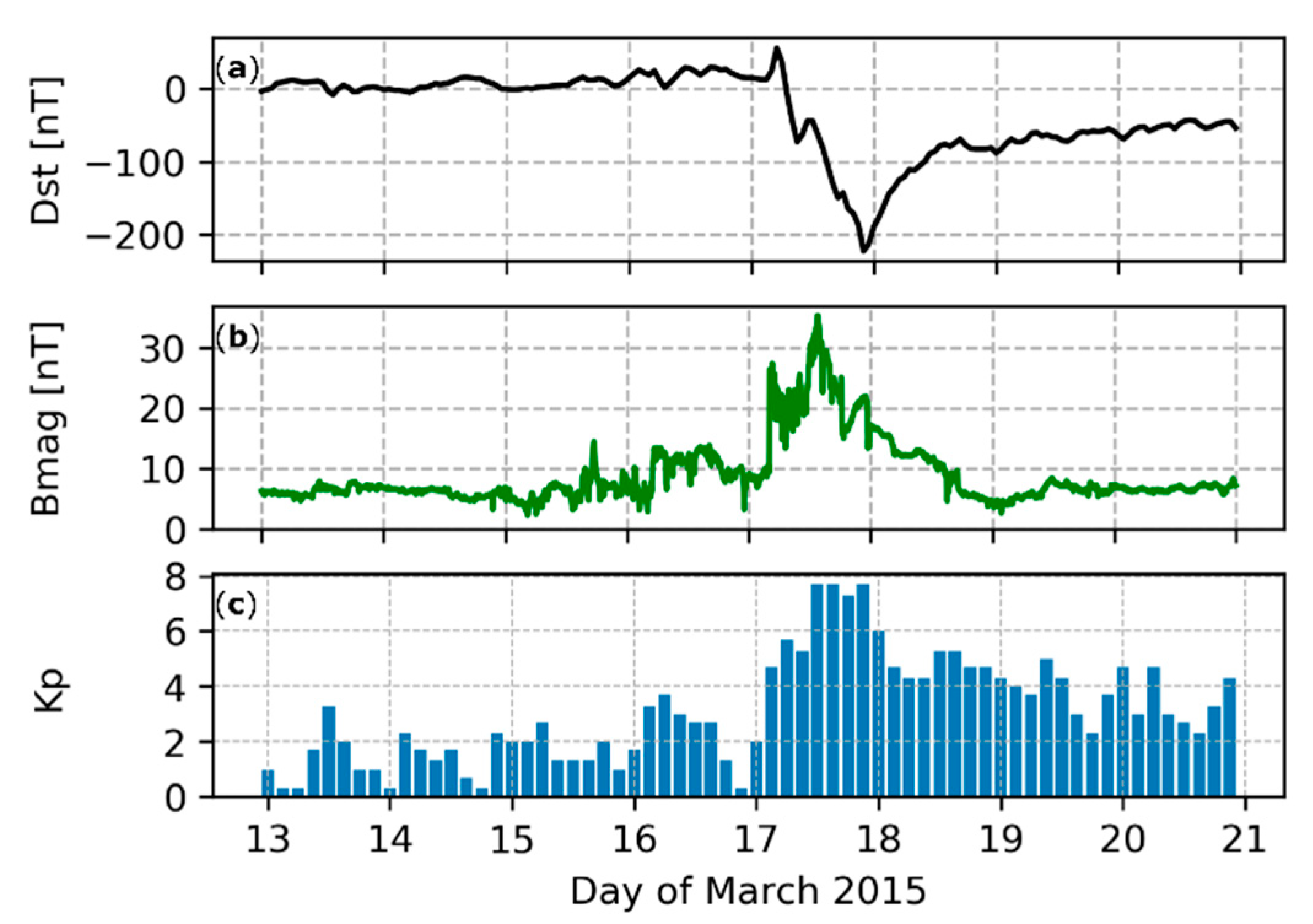
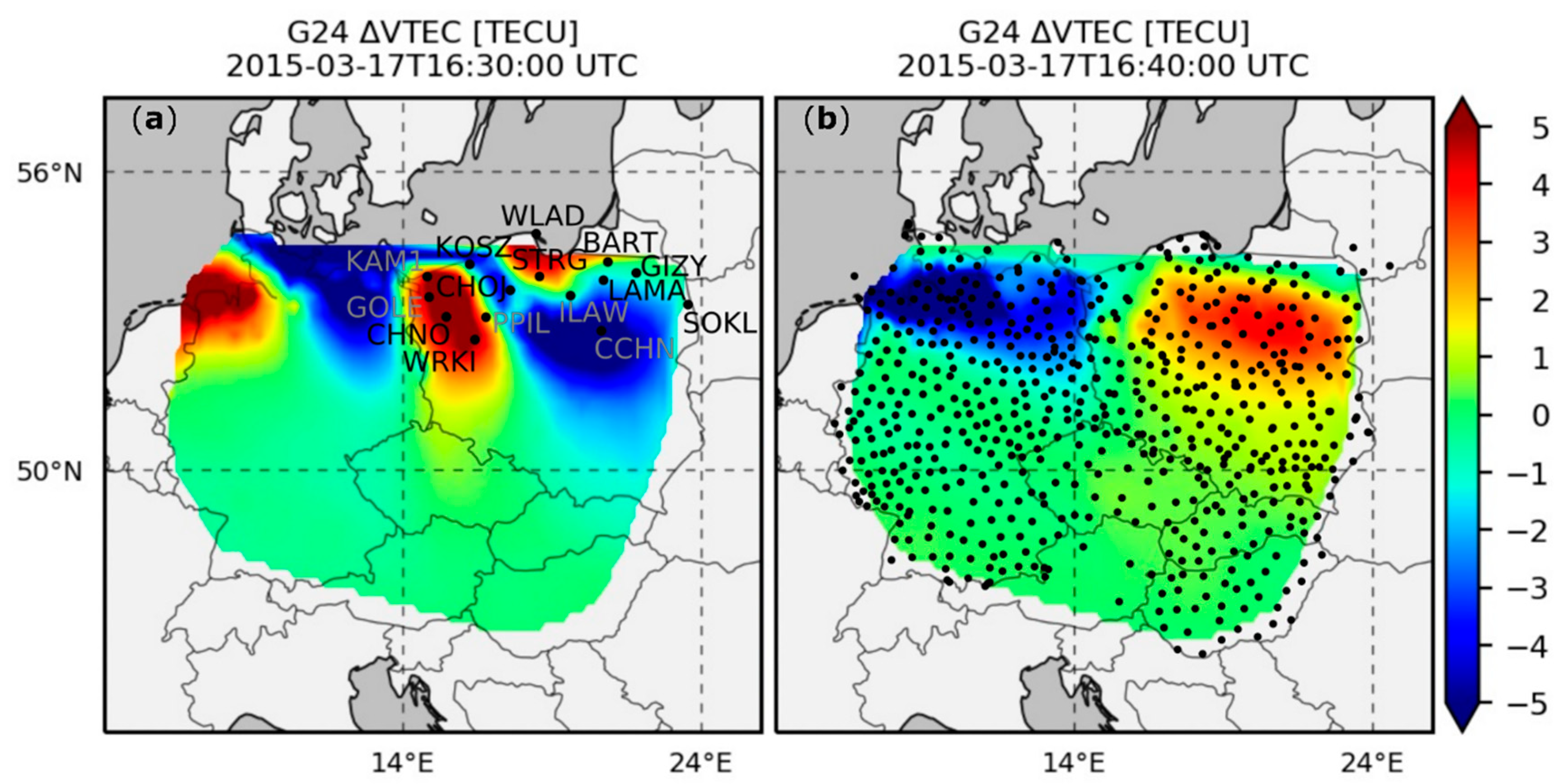


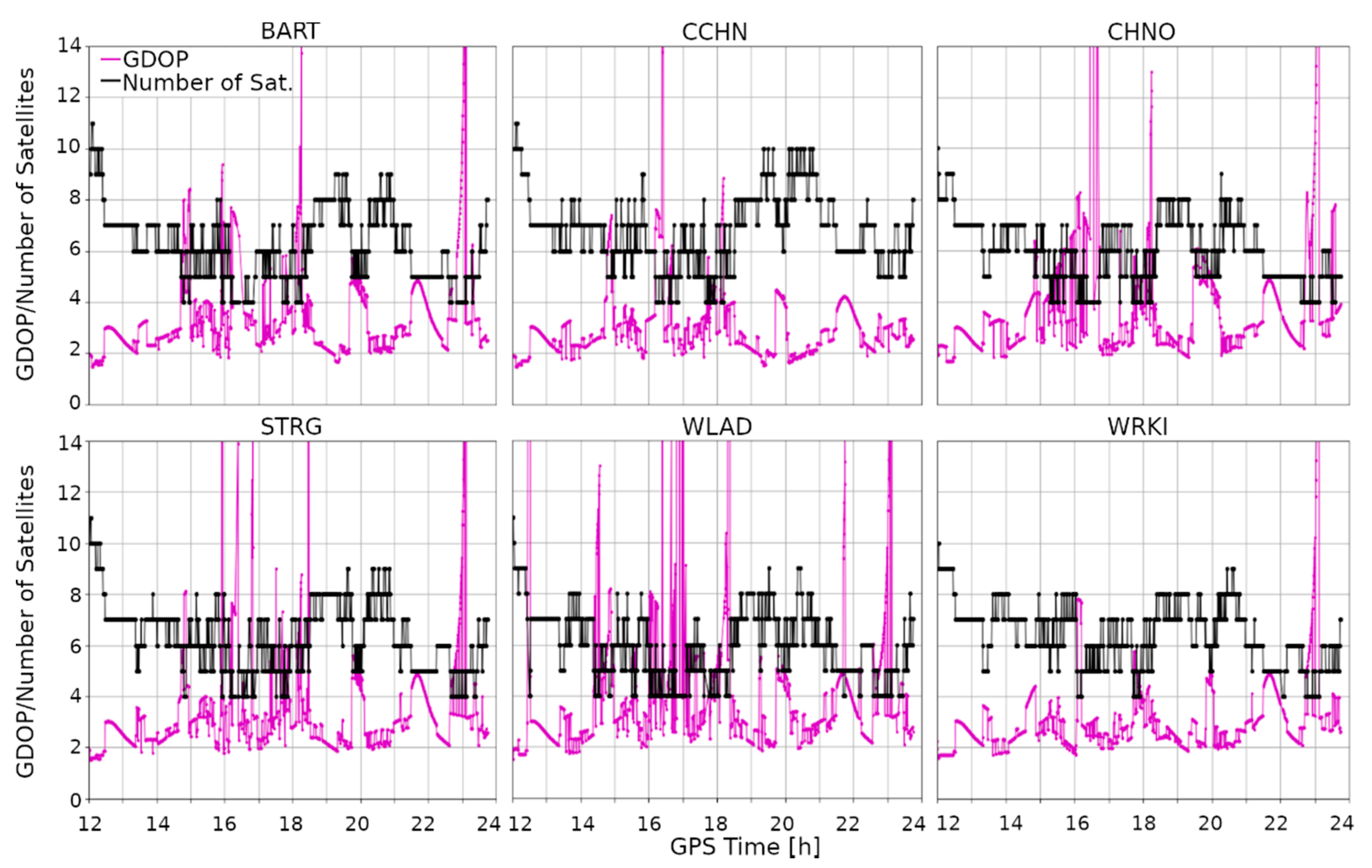
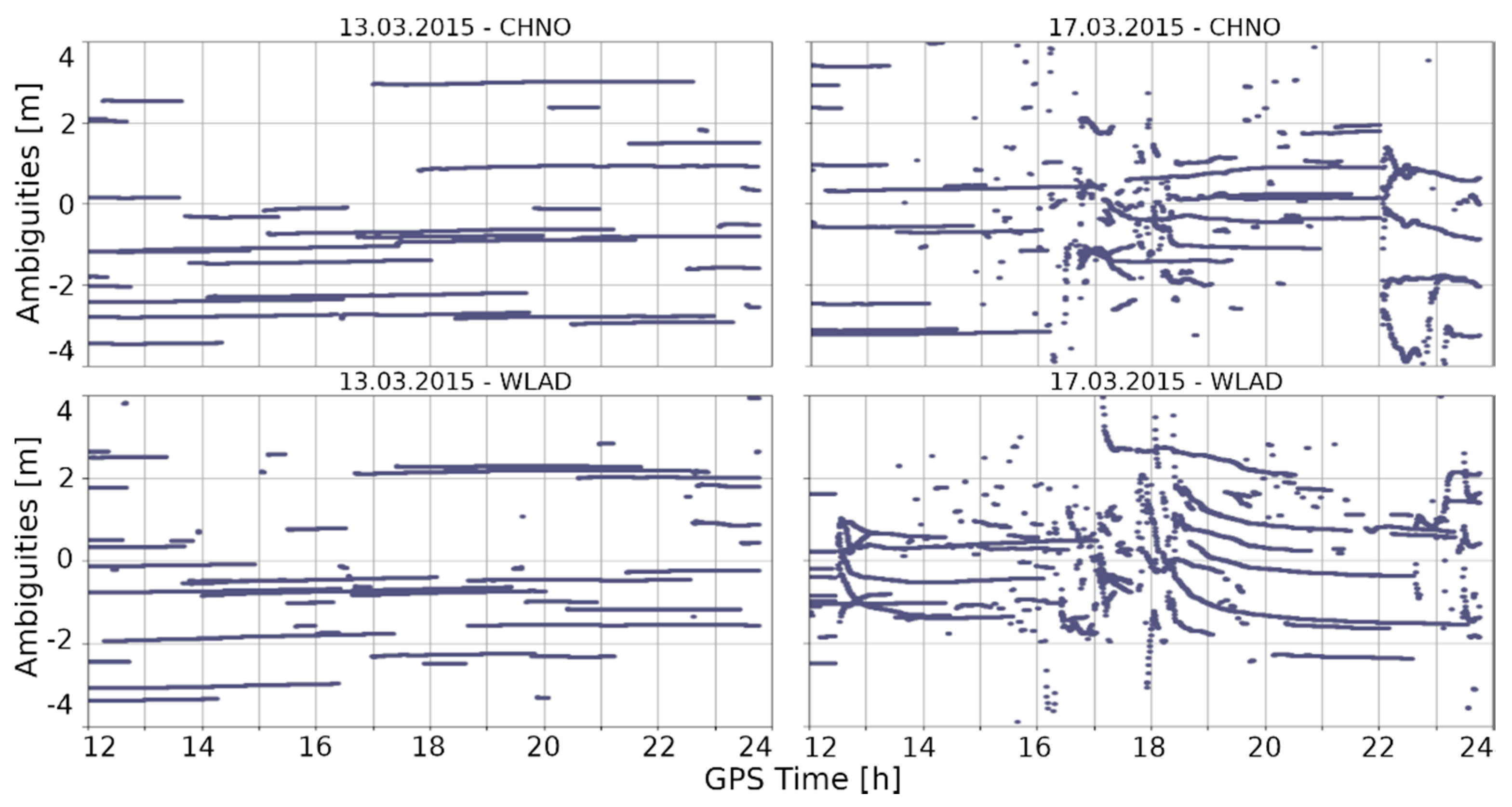

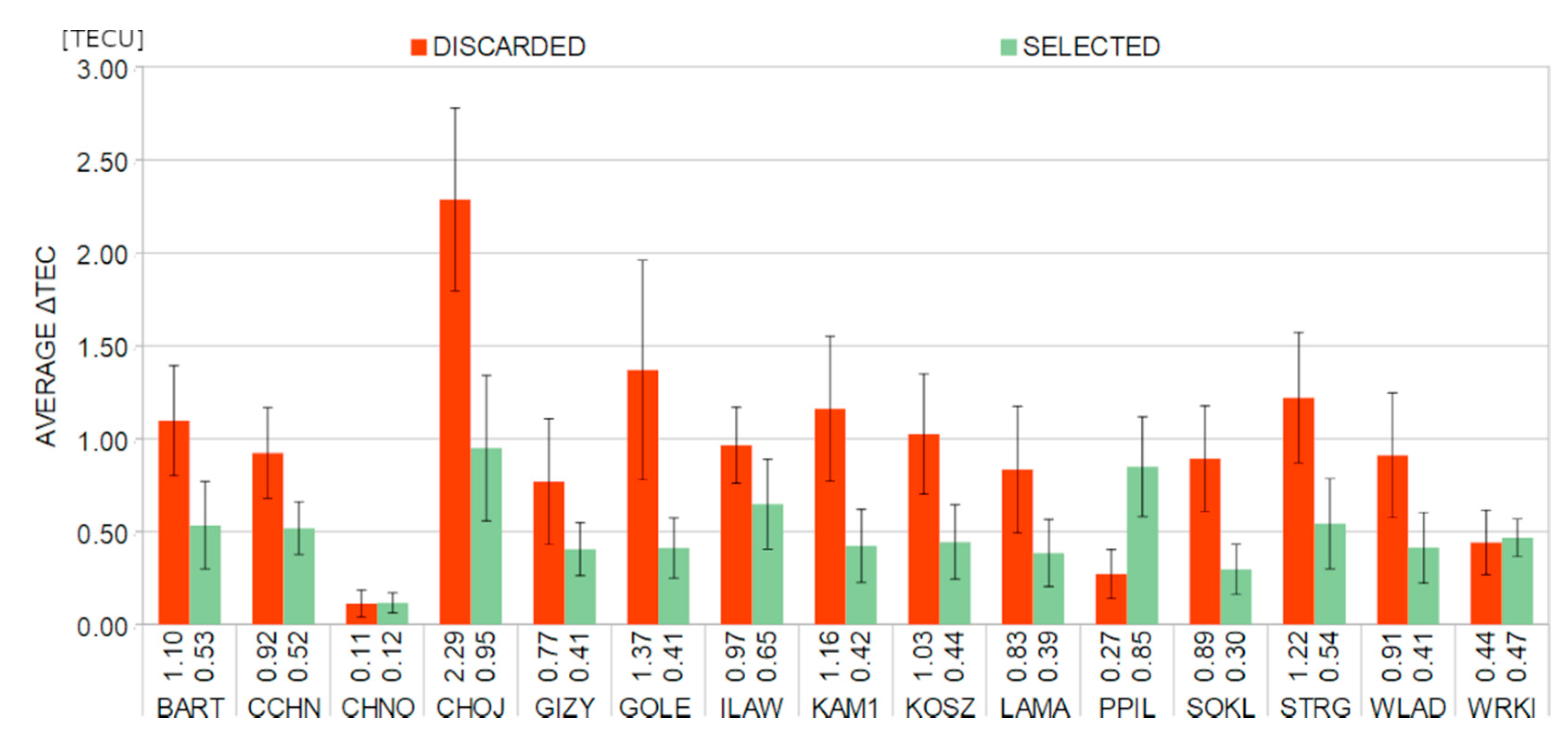
| GNSS Station | RMS (m) | |||||
|---|---|---|---|---|---|---|
| Quiet Day (13 March 2015) | Stormy Day (17 March 2015) | |||||
| North | East | Up | North | East | Up | |
| BART | 0.02 | 0.02 | 0.04 | 0.24 | 0.21 | 0.52 |
| CCHN | 0.01 | 0.02 | 0.03 | 0.15 | 0.06 | 0.11 |
| CHNO | 0.01 | 0.01 | 0.03 | 0.50 | 0.33 | 0.61 |
| CHOJ | 0.01 | 0.01 | 0.03 | 0.28 | 0.23 | 0.63 |
| GIZY | 0.01 | 0.01 | 0.03 | 0.24 | 0.24 | 0.42 |
| GOLE | 0.02 | 0.03 | 0.05 | 0.56 | 0.28 | 0.67 |
| ILAW | 0.01 | 0.01 | 0.03 | 0.13 | 0.06 | 0.06 |
| KAM1 | 0.01 | 0.01 | 0.03 | 0.30 | 0.25 | 0.92 |
| KOSZ | 0.02 | 0.02 | 0.04 | 0.53 | 0.53 | 0.99 |
| LAMA | 0.01 | 0.01 | 0.03 | 0.30 | 0.38 | 0.38 |
| PPIL | 0.01 | 0.01 | 0.02 | 0.49 | 0.23 | 0.5 |
| SOKL | 0.02 | 0.02 | 0.04 | 0.39 | 0.21 | 0.27 |
| STRG | 0.01 | 0.01 | 0.02 | 0.37 | 0.28 | 0.79 |
| WLAD | 0.02 | 0.01 | 0.03 | 0.69 | 0.43 | 1.37 |
| WRKI | 0.02 | 0.02 | 0.04 | 0.34 | 0.20 | 0.45 |
| Average | 0.02 ± 0.01 | 0.02 ± 0.01 | 0.03 ± 0.01 | 0.37 ± 0.16 | 0.26 ± 0.12 | 0.58 ± 0.34 |
Publisher’s Note: MDPI stays neutral with regard to jurisdictional claims in published maps and institutional affiliations. |
© 2020 by the authors. Licensee MDPI, Basel, Switzerland. This article is an open access article distributed under the terms and conditions of the Creative Commons Attribution (CC BY) license (http://creativecommons.org/licenses/by/4.0/).
Share and Cite
Poniatowski, M.; Nykiel, G. Degradation of Kinematic PPP of GNSS Stations in Central Europe Caused by Medium-Scale Traveling Ionospheric Disturbances During the St. Patrick’s Day 2015 Geomagnetic Storm. Remote Sens. 2020, 12, 3582. https://doi.org/10.3390/rs12213582
Poniatowski M, Nykiel G. Degradation of Kinematic PPP of GNSS Stations in Central Europe Caused by Medium-Scale Traveling Ionospheric Disturbances During the St. Patrick’s Day 2015 Geomagnetic Storm. Remote Sensing. 2020; 12(21):3582. https://doi.org/10.3390/rs12213582
Chicago/Turabian StylePoniatowski, Mateusz, and Grzegorz Nykiel. 2020. "Degradation of Kinematic PPP of GNSS Stations in Central Europe Caused by Medium-Scale Traveling Ionospheric Disturbances During the St. Patrick’s Day 2015 Geomagnetic Storm" Remote Sensing 12, no. 21: 3582. https://doi.org/10.3390/rs12213582






